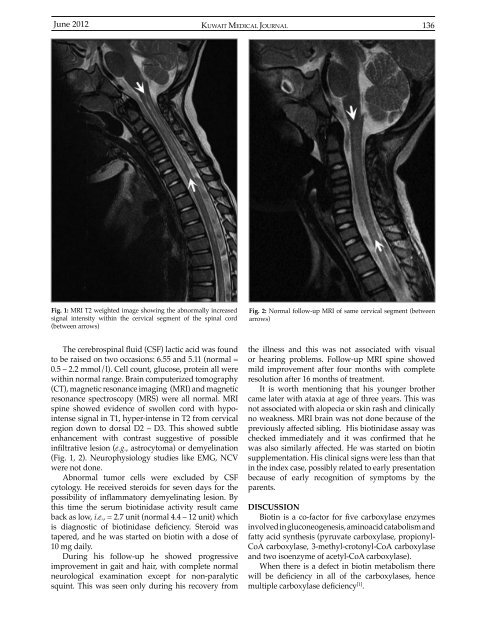Vol 44 # 2 June 2012 - Kma.org.kw
Vol 44 # 2 June 2012 - Kma.org.kw
Vol 44 # 2 June 2012 - Kma.org.kw
Create successful ePaper yourself
Turn your PDF publications into a flip-book with our unique Google optimized e-Paper software.
<strong>June</strong> <strong>2012</strong><br />
KUWAIT MEDICAL JOURNAL 136<br />
Fig. 1: MRI T2 weighted image showing the abnormally increased<br />
signal intensity within the cervical segment of the spinal cord<br />
(between arrows)<br />
Fig. 2: Normal follow-up MRI of same cervical segment (between<br />
arrows)<br />
The cerebrospinal fluid (CSF) lactic acid was found<br />
to be raised on two occasions: 6.55 and 5.11 (normal =<br />
0.5 – 2.2 mmol/l). Cell count, glucose, protein all were<br />
within normal range. Brain computerized tomography<br />
(CT), magnetic resonance imaging (MRI) and magnetic<br />
resonance spectroscopy (MRS) were all normal. MRI<br />
spine showed evidence of swollen cord with hypointense<br />
signal in T1, hyper-intense in T2 from cervical<br />
region down to dorsal D2 – D3. This showed subtle<br />
enhancement with contrast suggestive of possible<br />
infiltrative lesion (e.g., astrocytoma) or demyelination<br />
(Fig. 1, 2). Neurophysiology studies like EMG, NCV<br />
were not done.<br />
Abnormal tumor cells were excluded by CSF<br />
cytology. He received steroids for seven days for the<br />
possibility of inflammatory demyelinating lesion. By<br />
this time the serum biotinidase activity result came<br />
back as low, i.e., = 2.7 unit (normal 4.4 – 12 unit) which<br />
is diagnostic of biotinidase deficiency. Steroid was<br />
tapered, and he was started on biotin with a dose of<br />
10 mg daily.<br />
During his follow-up he showed progressive<br />
improvement in gait and hair, with complete normal<br />
neurological examination except for non-paralytic<br />
squint. This was seen only during his recovery from<br />
the illness and this was not associated with visual<br />
or hearing problems. Follow-up MRI spine showed<br />
mild improvement after four months with complete<br />
resolution after 16 months of treatment.<br />
It is worth mentioning that his younger brother<br />
came later with ataxia at age of three years. This was<br />
not associated with alopecia or skin rash and clinically<br />
no weakness. MRI brain was not done because of the<br />
previously affected sibling. His biotinidase assay was<br />
checked immediately and it was confirmed that he<br />
was also similarly affected. He was started on biotin<br />
supplementation. His clinical signs were less than that<br />
in the index case, possibly related to early presentation<br />
because of early recognition of symptoms by the<br />
parents.<br />
DISCUSSION<br />
Biotin is a co-factor for five carboxylase enzymes<br />
involved in gluconeogenesis, aminoacid catabolism and<br />
fatty acid synthesis (pyruvate carboxylase, propionyl-<br />
CoA carboxylase, 3-methyl-crotonyl-CoA carboxylase<br />
and two isoenzyme of acetyl-CoA carboxylase).<br />
When there is a defect in biotin metabolism there<br />
will be deficiency in all of the carboxylases, hence<br />
multiple carboxylase deficiency [1] .
















